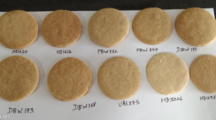Abstract
The results of the study into the effect of the wheat-triticale grain grinding mixture ratio on the milling and baking properties of wheat-triticale flour are presented. The flour and baking properties of the initial grain wheat-triticale grain mixture in 80 : 20, 70 : 30, 60 : 40, and 50 : 50 ratios and the control grain of wheat were determined. The milling properties of the initial grain mixtures were determined in MLP-4 laboratory mills with rifled and microrough rollers. It was found that adding triticale grain to the grinding grain mixture reduces the yield of flour from 0.5% when adding 20% triticale grain to 3.2% when adding 50% triticale grain. The addition of triticale grains to the initial grinding grain mixture has the greatest influence on the fall number of wheat-triticale flour. In this case, there is a 3.5-fold decrease in the falling number from 294 s for a control sample of wheat to 80 s in flour obtained from a grain mixture at a 50 : 50 ratio of wheat and triticale. In this case, the addition of triticale grain to the grinding mixture slightly decreases the volumetric yield of bread from 0.2 g/cm3 with a 80 : 20 ratio of wheat and triticale to 0.4 g/cm3 with a 50 : 50 ratio. The shape stability of hearth bread is reduced even less—from 0.1 when the ratio of wheat and triticale is 80 : 20 to 0.2 at a 50 : 50 ratio. The addition of triticale to the grinding grain mixture has the greatest influence on the porosity of the bread. Compared to the control sample of bread from wheat flour, the porosity of bread from wheat and triticale flour in the 80 : 20 ratio decreased by 0.6%, and it decreased by 8.2% from wheat and triticale flour in the 50 : 50 ratio.


Similar content being viewed by others
REFERENCES
Aguirre, A., Borneo, R., and León, A.E., Properties of triticale flour protein based films, LWT—Food Sci. Technol., 2011, vol. 44, no. 9, pp. 1853–1858.
Fernandez-Figares, I., Amino-acid composition and protein and carbohydrate accumulation in the grain of triticale grown under terminal water stress simulated by a senescing agent, J. Cereal Sci., 2000, vol. 32, no. 3, pp. 249–258.
Győri, Z., Examination of technological and nutritional properties bread made from triticale flour, Flour-Bread ’09: 5th International and 7th Croation Congress of Cereal Technology, Osijek: Univ. of Osijek, 2010, pp. 503–507.
Pena, R.J. and Amaja, A., Milling and breadmaking properties of wheat-triticale grain blends, J. Sci. Food Agric., 1992, vol. 60, no. 4, pp. 483–487.
Kruppa, J. and Hoffmann, B., New triticale varieties for food and feed, Grain Res. Dev. Environ., 2006, vol. 20, no. 4, pp. 43–45.
Pena, R.J., Food uses of triticale, in Triticale Improvement and Production, Mergoum, M. and Gómez-MacPherson, H., Eds., FAO, 2004, pp. 37–48.
Seguchi, M., Breadmaking properties of triticale flour with wheat flour and relationship to amylase activity, J. Food Sci., 1999, vol. 64, no. 4, pp. 582–586.
Tohver, M., Quality of triticale cultivars suitable for growing and bread-making in northern conditions, Food Chem., 2005, vol. 89, no. 1, pp. 125–13.
Perez, G.T., León, A.E., Ribotta, P.D., Aguirre, A., Rubiolo, O.J., and Añón, M.C., Use of triticale flours in cracker-making, Eur. Food Res. Technol., 2003, vol. 217, pp. 134–137.
Martinek, P., Agronomic and quality characteristics of triticale (× Triticosecale Wittmack) with HMW glutenin subunits 5+10, J. Cereal Sci., 2008, vol. 47, no. 1, pp. 68–78.
Fraś, A., Variability in the chemical composition of triticale grain, flour and bread, J. Sci., 2016, vol. 71, pp. 66–72.
Gil, Z., Effect of physical and chemical properties of triticale grain on its milling value, Plant Breed. Plant Sci., 2002, vol. 46, no. 1, pp. 23–29.
Grabovets, A.I., Krokhmal, A.V., Dremucheva, G.F., and Karchevskaya, O.E., Breeding of triticale for baking purposes, Russ. Agric. Sci., 2013, no. 39, pp. 197–202.
Kandrokov, R.H., Pankratov, G.N., Meleshkina, E.P., Vitol, I.S., and Tulyakov, D.G., Effective technological scheme for processing triticale grain into high-quality baker’s grade flour, Foods Raw Mater., 2019, vol. 7, no. 1, pp. 107–117.
Hosseinian, F.S. and Mazza, G., Triticale bran and straw: Potential new sources of phenolic acids, proanthocyanidins, and lignans, J. Funct. Foods, 2009, vol. 1, no. 1, pp. 57–64.
Tayyar, S., Some chemical and technological properties of Turkish triticale (Triticosecale Wittm.) genotypes, Rom. Biotechnol. Lett., 2014, vol. 19, no. 6, pp. 9891–9898.
Rakha, A., Dietary fiber in triticale grain: Variation in content, composition, and molecular weight distribution of extractable components, J. Cereal Sci., 2011, vol. 54, no. 3, pp. 324–331.
Peña, R.J. and Amaya, A., Milling and breadmaking properties of wheat-triticale grain blends, J. Sci. Food Agric., 1992, vol. 60, no. 4, pp. 483–487. doi 10.10022740600413
Kandrokov, R.H. and Pankratov, G.N., Development of an efficient technological scheme for triticale grain processing into graded bread flour, Russ. Agric. Sci., 2019, vol. 45, pp. 216–219.
Kandrokov, R.Kh. Technological properties of wheat–triticale flour, Vestn. Yuzhno-Ural. Gos. Univ., Ser.: Pishch. Biotekhnol., 2019, vol. 7, no. 3, pp. 13–22.
Author information
Authors and Affiliations
Corresponding author
Ethics declarations
The authors declare that they have no conflict of interest. This article does not contain any studies involving animals or human participants performed by any of the authors.
Additional information
Translated by S. Avodkova
About this article
Cite this article
Kandrokov, R.K., Yudina, T.A., Ruban, N.V. et al. The Effect of the Wheat and Triticale Grain Mixture Ratio on Technological Properties of Wheat Triticale Flour. Russ. Agricult. Sci. 47, 177–181 (2021). https://doi.org/10.3103/S1068367421020099
Received:
Revised:
Accepted:
Published:
Issue Date:
DOI: https://doi.org/10.3103/S1068367421020099




